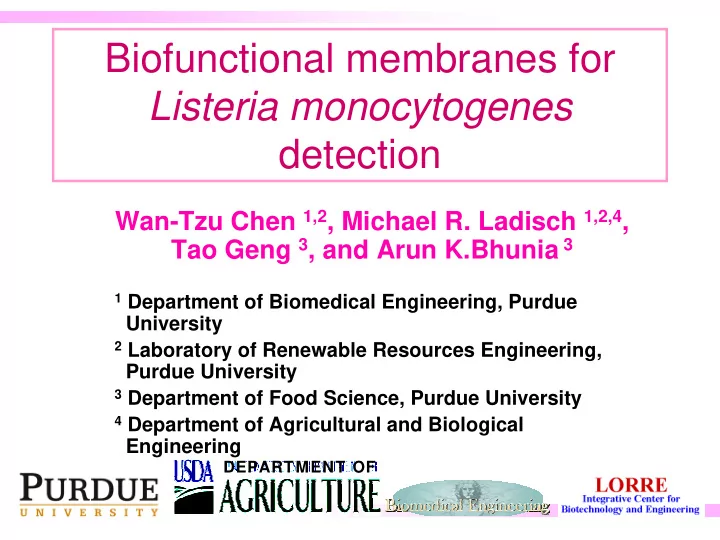

Biofunctional membranes for Listeria monocytogenes detection Wan-Tzu Chen 1,2 , Michael R. Ladisch 1,2,4 , Tao Geng 3 , and Arun K.Bhunia 3 1 Department of Biomedical Engineering, Purdue University 2 Laboratory of Renewable Resources Engineering, Purdue University 3 Department of Food Science, Purdue University 4 Department of Agricultural and Biological Engineering DEPARTMENT OF
Acknowledgements � Dr. Richard Linton � Dr. Rashid Bashir � Dr. Deb Sherman and Chia-Ping Huang � Dr. Soo-Il Lee This research was supported through a DEPARTMENT OF cooperative agreement with the ARS of the United States Department of Agriculture project number 1935-42000- 035
Foodborne Pathogens � Bacteria, Virus and Parasite � Potential Hazardous Food � Temperature, acidity, time, oxygen…..etc � Syndromes � Abdominal pains, vertigo, diarrhea, intoxication….etc � Examples � C. botulinim, Salmonella, L. monocytogenes
Listeria monocytogenes � Gram-positive, rod-shaped bacterium � Highly resistant to salt and low temperature � Conventional Sample Preparation Method (BAM, 1998) � Enrichment broth � Oxford or LPM agars � TSBYE agar � Rapid Sample Preparation Method � Membrane filtration � Decreased culture time
Syringe Filter System Different volumes being filtered PVDF Membrane Inoculated hotdog meat Nylon filters broth (HDM) ~700 cells/ml Mixed cellulose Polycarbonate Membrane immersing in In 0.45 um and Filtrates 0.5 ml of PBS with 1% of 0.22 um nominal Tween 20 for 30 minutes size Plate out 100 µl on Bradford Protein Assay MOX agar
Tween 20 � Non-ionic surfactant � Produce surface liquid tension � Prevent protein binding � Hence help Listeria recovery
0.45 um with Tween 20 100 90 Polycarbonate 0.4 um 80 Mixed cellulose 0.45 um 70 Concentration factors Theoretic maximal 60 concentration factors 50 40 30 20 10 0 1 mL 5 mL 10 mL 25 mL 50 mL Filtered volumes (ml)
Smaller Pore Sizes 100 90 Nucleopore 0.2 um 80 Nucleopore 0.4 um MicronSep 0. 22 um 70 Concentrated factors MicronSep 0.45 um 60 50 40 30 20 10 0 1 mL 5 mL 10 mL 25 mL 50 mL Filtered volumes (ml)
Different Pore Structures Mixed Cellulose (Depth filter) Polycarbonate (Screen filter) Listeria monocytogenes Ladisch, 2001
More Dilute Samples (15 cells/ml) 1100 1800 cells/mL 900 number of cells recovered 700 y = 10.352x - 1.2721 2 = 0.9863 R 500 300 cell number vs. filtered volume Linear (cell number vs. filtered volume) 100 0 20 40 60 80 100 -100 Filtered volume(ml) Recovery rate~70% = 37 cells/ 20 ul Volume below 0.13 ml results in no bacteria recovered
Antibodies Membrane Bacteria New Thoughts
Chemistry of Antibodies Immobilization C H 3 C H 3 O O O C O C C O C C H 3 C H 3 Poly-lysine Poly-Lysine C O C H 3 O O C O C N (C H 2 ) 4 C H H NH C H 3 C O Glutaraldehyde NH 2 (C H 2 ) 4 C H G lutaraldehyde NH C O C H 3 O O (C H 2 ) 4 C H O C C N H NH C H 3 C O (C H 2 ) 3 C H O C H N (C H 2 ) 4 ) C H NH Enzyme Enzym e Antibody P66 C O C H 3 O (C H 2 ) 4 C H Suye et al., 1998, Biotechnol Appl O C O C N H NH C H 3 Biochem. 27: 245-248. C O Enzym e (C H 2 ) 3 N C H C H N (C H 2 ) 4 ) C H NH
Antibody Immobilization LG surface + FITC-P66 Membrane+Poly-Lysine+Glutaraldehyde (LG surface)
Listeria on Different Surfaces 5*10 7 cells/ml Listeria on LG surface– HIGH Listeria on BSA surface- non-specific binding! blocking non-specific binding
Antibody Listeria on P66 surfaces BSA Specific Binding Blank LG surface Initial=5*10 7 cells/ml
Non-specific E coli Binding E. Coli on P66 surfaces Blank LG surface Initial= 5*10 7 cells/ml
Conclusions � Membrane filtration helps separation � Tween 20 treatment facilitates Listeria recovery � Recovery increases as pore sizes decrease � Antibody immobilization works well on PC � Bacteria differentiation can be carried out
Recommend
More recommend